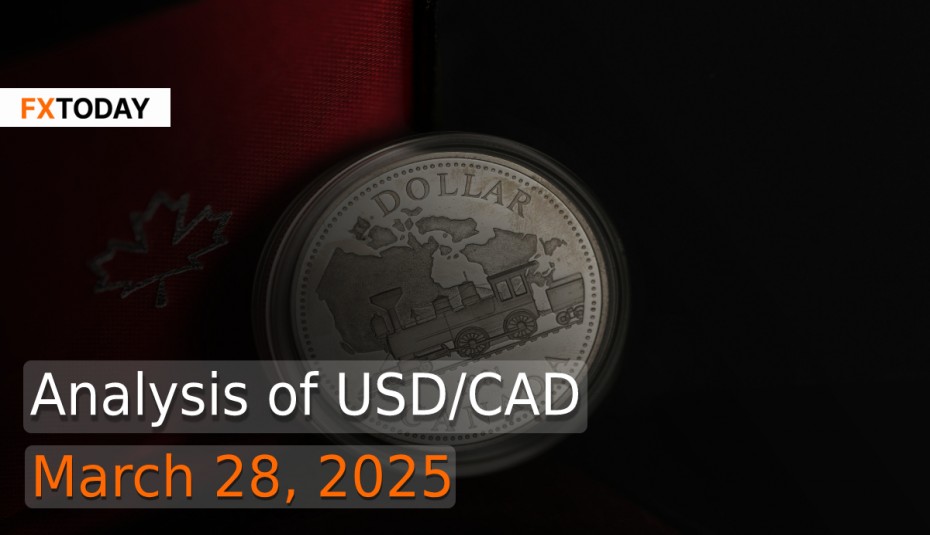Canadian Dollar Edges Up Amid U.S. Tariff Pressures
The Canadian dollar has risen by 0.5% this year despite U.S. tariff pressures. Meanwhile, Ontario anticipates a reduction in the impact of U.S. auto tariffs on Canada following a discussion between U.S. Commerce Secretary Howard Lutnick and Premier Doug Ford. However, President Trump has warned of significant tariff increases on Canada, citing economic harm concerns. His administration recently imposed a 25% tariff on automotive imports, set to take effect on April 3, while Canadian Prime Minister Mark Carney has called the tariffs a direct attack on Canadian workers, hinting at possible countermeasures.
In response to economic uncertainty from tariffs, the Bank of Canada cut interest rates by 25 basis points to 2.75% on March 12. The central bank noted easing inflationary risks but acknowledged that tariffs could slow domestic demand. Although inflation has remained close to 2% for months, a recent spike to 2.6% suggests growing price pressures. The bank's governing council remains cautious, emphasizing the need for careful monitoring of tariff-related economic effects before providing further guidance on monetary policy.
Canada's labor market showed resilience in early 2025, with payroll employment rising by 26,800 in January following a 66,400 increase in December. Gains were seen in education, retail, and healthcare, while construction and hospitality sectors faced job losses. However, job vacancies declined significantly, dropping by 136,700 (-20.6%) year-over-year, with notable decreases in transportation, finance, and education sectors. The unemployment-to-job vacancy ratio increased to 2.8, reflecting a weaker labor market.
Manufacturing and retail sales data suggest economic headwinds. Canadian factory sales likely declined by 0.2% in February, primarily due to weaker food and petroleum sales. Retail sales fell 0.6% in January, exceeding forecasts, with auto and grocery sales contributing to the decline. The drop is attributed to post-holiday normalization and the expiration of a sales tax break. Analysts predict that tariff-related consumer uncertainty will weigh on spending in the coming months, with GDP growth likely slowing as a result.
The U.S. dollar showed mixed movement on Thursday as traders assessed the severity of tariffs that President Donald Trump is set to unveil next week. Optimism about Trump's flexibility on tariffs had previously boosted market sentiment, but uncertainty remained ahead of his April 2 announcement on reciprocal tariffs. On Wednesday, he imposed a 25% tariff on imported cars and light trucks, prompting threats of retaliation from countries such as Canada and France. These trade tensions, along with concerns over the impact on economic growth, pushed the dollar toward a steady weekly performance and a projected quarterly decline as lower U.S. yields and stock market downturns weighed on the currency.
Economic data revealed that U.S. growth slowed in the fourth quarter, with GDP rising at an annualized 2.4%, slightly above the prior estimate of 2.3% but down from 3.1% in the previous quarter. The revision reflected reduced imports, which contributed positively to GDP calculations, though weaker investment partially offset gains in consumer and government spending. Analysts remain cautious about the economic outlook, as Trump's aggressive tariff strategy and adverse weather conditions in early 2025 could further dampen growth.
Meanwhile, the U.S. labor market showed resilience, with initial jobless claims falling slightly to 224,000 in the week ending March 22. Despite Trump's drastic efforts to shrink the federal government, including mass firings and deep spending cuts, overall layoffs remained low. However, job losses in the Washington, D.C., area have risen, likely due to government-dependent contractors losing funding. The unemployment rate is expected to hold at 4.1%, supported by steady hiring.
Financial liquidity in the U.S. has surged, with commercial bank deposits and money market fund assets increasing by $1.2 trillion in 2024, following a $1 trillion rise in 2023. JPMorgan analysts attributed this rapid money supply expansion to the Federal Reserve’s unexpected slowdown in quantitative tightening and rising bank lending. The firm projects a 6.4% liquidity expansion for 2025, significantly outpacing its nominal GDP forecast of 3.5%.
Trade data showed a narrowing of the U.S. goods trade deficit in February, driven by a $7 billion rise in exports and a slight decline in imports. The deficit shrank by 4.9% to $147.9 billion, easing concerns about an economic slowdown in the first quarter. In housing, contracts for previously owned homes saw a modest rebound in February, rising 2.0% as lower mortgage rates provided temporary relief. However, economic uncertainty may limit sustained momentum in the housing market.
Given these dynamics, USD/CAD could see near-term fluctuations. If risk sentiment deteriorates and U.S. economic conditions worsen, USD/CAD could test resistance near 1.45. However, if Canada’s economic data stabilizes and trade negotiations ease tensions, the pair may pull back toward 1.40 in the short term.
Data for Technical Analysis (1D) CFD USD/CAD
Resistance : 1.4326, 1.4343, 1.4370
Support : 1.4272, 1.4255, 1.4228
1D Outlook
Source: TradingView
Buy/Long 1 If the support at the price range 1.4202 - 1.4272 is touched, but the support at 1.4272 cannot be broken, the TP may be set around 1.4339 and the SL around 1.4167, or up to the risk appetite.
Buy/Long 2 If the resistance can be broken at the price range of 1.4326 - 1.4396, TP may be set around 1.4433 and SL around 1.4237, or up to the risk appetite.
Sell/Short 1 If the resistance at the price range 1.4326 - 1.4396 is touched, but the resistance 1.4326 cannot be broken, the TP may be set around 1.4268 and the SL around 1.4431, or up to the risk appetite.
Sell/Short 2 If the support can be broken at the price range of 1.4202 - 1.4272, TP may be set around 1.4145 and SL around 1.4361, or up to the risk appetite.
Pivot Points Mar 28, 2025 03:04AM GMT
|
Name
|
S3
|
S2
|
S1
|
Pivot Points
|
R1
|
R2
|
R3
|
|---|---|---|---|---|---|---|---|
| Classic | 1.4197 | 1.4228 | 1.4268 | 1.4299 | 1.4339 | 1.437 | 1.441 |
| Fibonacci | 1.4228 | 1.4255 | 1.4272 | 1.4299 | 1.4326 | 1.4343 | 1.437 |
| Camarilla | 1.4287 | 1.4294 | 1.43 | 1.4299 | 1.4314 | 1.432 | 1.4327 |
| Woodie's | 1.4201 | 1.423 | 1.4272 | 1.4301 | 1.4343 | 1.4372 | 1.4414 |
| DeMark's | - | - | 1.4283 | 1.4306 | 1.4354 | - | - |
Sources: Investing 1, Investing 2
















